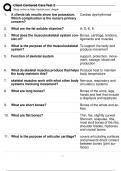Client Centered Care Test 2
Study online at https://quizlet.com/_diegsh
1. A clients lab results show low potassium. Cardiac dysrhythmias
Which complication is the nurse's primary
concern?
2. What are the fat soluble vitamins? A, D, E, K
3. What does the musculoskeletal system con- Bones, cartilage, tendons,
sist of? ligaments and muscles
4. What is the purpose of the musculoskeletal To support the body and
system? produce movement
5. Function of skeletal system support, protection, move-
ment, storage, blood cell
production
6. What do skeletal muscles produce that helps Produce heat to maintain
the body maintain this? body temperature
7. skeletal muscles work with what other body Nervous, respiratory and
systems involving movement? circulatory systems
8. What are long bones? Bones of the arms, legs,
hands and feet that include
a diaphysis and epiphysis
9. What are short bones? Bones of the wrists and an-
kles
10. What are flat bones? Thin, flat, slightly curved
Sternum, scapulae, ribs,
most skull bones of the ribs,
shoulder blades, hipbones
and cranial bones
11. What is the purpose of articular cartilage? covers articulating surfaces
and prevents direct contact
between bones (joint sur-
faces)
, Client Centered Care Test 2
Study online at https://quizlet.com/_diegsh
12. What is the purpose of periosteum? Gives bone strength, Pro-
vide blood vessels and nu-
trients to bone, Give a nerve
supply
13. What is the purpose of ligaments? help hold long bones to-
gether at joints
14. What is an osteoblast? a cell that secretes the ma-
trix for bone formation or re-
pair of bones
15. What are osteoclasts responsible for? Bone resorption. Osteo-
clasts secrete acid and en-
zymes that dissolve calcium
phosphate in bone as part
of repair of bones
16. antagonist muscle Muscles that have opposing
or opposite functions
17. synergistic muscles Muscles with the same
function or those that work
together to perform a partic-
ular function.
18. Myocytes muscle cells that devel-
op from myoblasts; cardiac
muscle
19. Flexion Decreases the angle of a
joint
20. extension increases the angle of a
joint (straightening)
21. isometric exercise exercise in which muscle
tension occurs without a
significant change of a body
part
, Client Centered Care Test 2
Study online at https://quizlet.com/_diegsh
22. muscle sense Knowing where our mus-
cles are without looking at
them
23. stretch receptors receptors that sense mus-
cle stretch and contraction
24. Immobility complications Decreased movement al-
lows respiratory secretions
to collect in the lungs which
can lead to atelectasis and
pneumonia
25. What systems does immobility affect? Cardiovascular, gastroin-
testinal tract, musculoskele-
tal system, urinary system
and the skin
26. What are respiratory complications from im- Stasis of secretions, atelec-
mobility? tasis, poor gas exchange
and pneumonia
27. What are cardiac complications from immo- Blood clots, pulmonary em-
bility? bolus, hypotension and
tachycardia
28. GI complications of immobility Weight loss, protein defi-
ciency, abdominal disten-
tion and constipation
29. Musculoskeletal complications from immo- Weakness, atrophy, joint
bility? contractures, osteoporosis
and bone pain
30. Urinary complications from immobility? Stasis of urine leading
to frequent UTI's, kidney
stones, urinary frequency
and dysuria
, Client Centered Care Test 2
Study online at https://quizlet.com/_diegsh
31. Skin complications from immobility? Decreased circulation and
pressure leading to skin
breakdown and pressure in-
juries
32. What can improper body mechanics cause? Pressure injuries, contrac-
tures, atrophy and respira-
tory complications
33. Describe two main principles for clients re- Maintain correct anatomical
garding body movement position and change posi-
tion frequently
34. supine position lying on back, facing up-
ward
35. Fowler's position a semi-sitting position; the
head of the bed is raised
between 60 and 90 degrees
36. Semi-Fowler's Position the head of the bed is raised
30 degrees; or the head of
the bed is raised 30 de-
grees and the knee portion
is raised 15 degrees
37. dorsal recumbent position lying on the back with the
knees flexed and soles of
feet flat on the bed
38. Dorsal Lithotomy Position Position used for examina-
tion of pelvic organs.For
example, delivery of baby,
ob/gyn exam. Like dorsal re-
cumbent but with feet usual-
ly in stirrups
39. lateral position side lying position
40. Sims position




